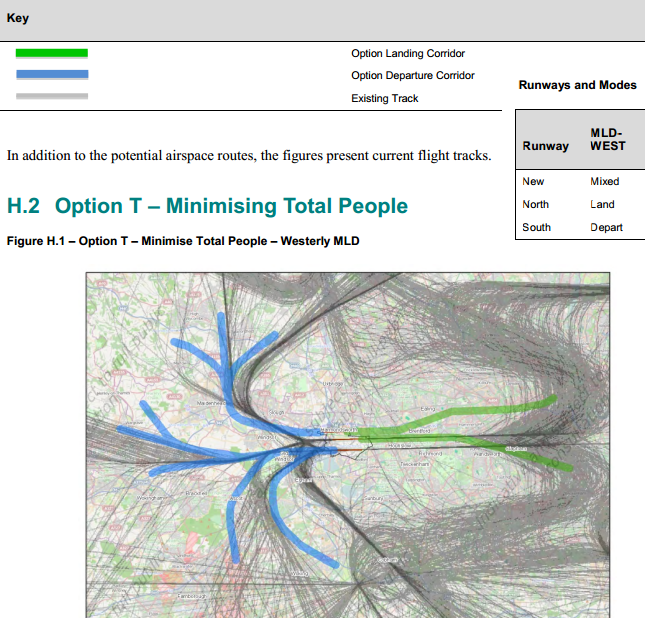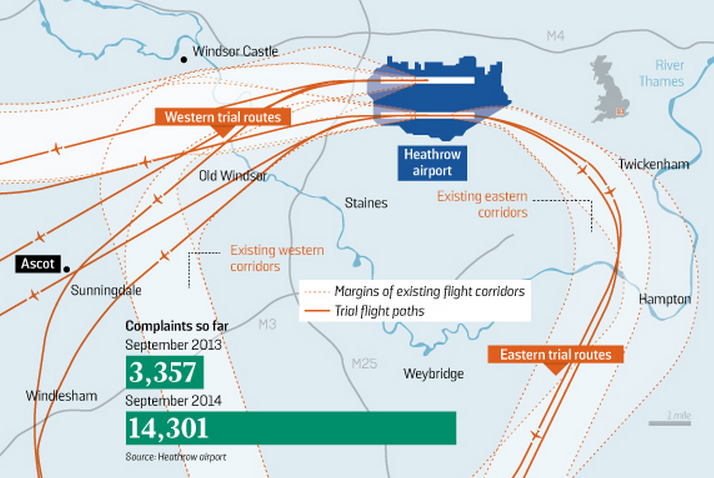Heathrow says flight paths being tested are “not indicative of future flight paths” Really?
Heathrow airport has managed to thoroughly upset and anger thousands or residents in areas affected by its flight path trials. The airport had some 500 complaints per day last month – the highest number in its history, and it can barely cope with them. There has been particular anger that there was no warning about the trials, even to the Mayor’s office or to local councils. The flight path changes are part of a drive to overhaul the UK’s airspace by 2020 and use more accurate precision navigation technology – which means narrow, concentrated flight paths that make things easier for air traffic control, to get more planes into the same airspace. NATS wants this “for the UK to remain competitive.” How Heathrow’s PR people have said that the routes being tested “are not indicative of future flight paths”. But that seems difficult to believe. Looking at maps produced by Heathrow earlier, for the Airports Commission, the routes there seem to be remarkably similar to those on trial, over Ascot and nearby areas. The document says they are “indicative and subject to consultation”. When is an indicative flight path not indicative ?
.
Tweet
Heathrow apologises over new flight path tests
6 October 2014
Image via Shutterstock
Residents of affluent commuter towns and villages are in uproar over low-flying aircraft as airports test new flight paths.
Heathrow was flooded by an average of 500 complaints a day last month – the highest number in its history – after it began using new flight paths over Berkshire and Surrey.
Residents in Ascot complained the aircraft noise was drowning out conversations and disturbing sleep. Some claim it will force them to move from the town.
The airport apologised for the disturbance caused by the trials, which began six weeks ago with no warning and will end early, because of the backlash, the Sunday Times reported.
Heathrow received 14,301 complaints last month, up from 3,357 in the same month last year. Last week the airport said it was ending the trial two months early on November 12.
London mayor Boris Johnson said the “colossal level of complaints” in recent weeks showed that building a third runway at Heathrow “will never be acceptable”.
“It is beyond belief that no warning was given to my office or to local residents that these trials were to begin, and I will be writing to the secretary of state to ask for a full explanation,” he told the newspaper.
Gatwick, Stansted, Birmingham, London City and Luton airports have also either designed new flight paths or are planning to fly aircraft in a more concentrated pattern on existing routes.
The changes are part of a drive to overhaul the UK’s airspace by 2020 and use more accurate navigation technology.
Instead of following navigational beacons on the ground when approaching or departing airports, aircraft will use satellite navigation.
This system, known as performance-based navigation, will allow pilots to fly their routes more precisely and noise will be concentrated along narrower flight paths.
It could also allow the distance between flight paths to be reduced and enable aircraft to make more fuel-efficient turns, and climb more quickly or descend later.
The change has prompted some airports and National Air Traffic Services to test new flight paths for departing aircraft flying below 4,000ft.
Heathrow is testing five departure routes. One goes over Ascot and Sunninghill in Berkshire and Windlesham and Lightwater in Surrey, while others concentrate flights over Old Windsor, Twickenham and Hampton.
Heathrow insisted the routes being tested “are not indicative of future flight paths”.
Sustainability and environment director Matt Gorman said: “We are sorry for communities that have experienced an increase in noise as a result of these trials. We are taking that feedback into account in the design of any future trials and in thinking about how we communicate about those trials.”
Birmingham airport has been testing two new flight paths for departing aircraft since May, which residents claim is causing misery in the villages of Balsall Common and Hampton in Arden.
Gatwick received about 200 complaints a day when a flight path was tested over West Sussex earlier this year.
At Stansted, Nats is proposing to double the number of aircraft flying over Essex towards Clacton, while cutting the number of flights departing towards the Thames.
London City is proposing a more concentrated flight path over Poplar, Leyton and Wanstead in east London but fewer flights over Romford. Luton would see fewer flights over St Albans but more flights over the village of Sandridge.
Nats said: “Modernising the airspace is essential for the UK to remain competitive.”
.
One comment below the article says:
“People” made conscious decisions to move to Ascot for the peace and quiet Jimbo, they didn’t move near the airport. And some of us have made sacrifices to do so. It’s different if you know you’re buying in to noise or have no choice.
Comment from an AirportWatch member:
This repeats the statement:
“Heathrow insisted the routes being tested “are not indicative of future flight paths.”
But on checking
http://your.heathrow.com/wp-content/uploads/2014/07/01-Heathrow-3RNW-Air-and-Ground-Noise-Assessment.pdf (contains many maps)
which presumably has been submitted to the Airports Commission as supporting technical data (it mentions the Requirements of the Airports Commission and their Sustainability Appraisal Framework (SAF) with respect to aircraft noise).
This shows many of the maps in Appendix H which contains very similar concentrated routes marked “indicative and subject to consultation”.
When is an indicative flight path not indicative ?
For example, this map below (Page 265 of the document. MLD means new runway Mixed, North runway Landings, South runway Departures):

Ascot appears to be overflown on pages 265,266,271,276,277,279 and 282. It even has a curved landing approach going over it in some options!
.
This document states:
“The routes presented should be seen as indicative of the principles and not definitive. Each route is presented as a 1 kilometre wide zone (500 metres either side of a centre line). The designs, while challenging some of today’s assumptions, are considered realistic and deliverable.”
and
“A significant programme of airspace modernisation is underway across Europe, including in the UK and in London which will be completed over the next decade. Airspace, often designed several decades ago, will be able to take advantage of the latest technology to navigate aircraft more precisely and operate more efficiently. Such ‘Precision Based Navigation’ (PBN) can also offer significant noise benefits. It allows routes to be redesigned more precisely to avoid the most densely populated areas. Heathrow recognise that this could mean a greater concentration of aircraft on specific tracks. However it will also be possible to create a number of routes for arrivals and departures, and to alternate these routes to deliver predicable periods of respite. ”
and
“All aircraft will operate using Precision Based Navigation (PBN). This system gives a high degree of accuracy to aircraft routing and positioning that enables shorter distances between aircraft on the same route. ”
and
It has been assumed the following when designing the take-off flight paths:
• All aircraft fly straight ahead to 1 nmi from the end of the runway to maintain an efficient operation and allow for aircraft separation requirements. These splits are not required from a runway being used in Departures and Landing mode (DL), as the assumption is that any two departures will be separated by an arrival;
• Turns in departure routes have a radius of not less than 2 nmi to allow for Code F size aircraft;
• Continuous climb departures can be conducted from all runways, independent parallel departures can be conducted from any two runways and routes from different runways in use at the same time must diverge;
• Required Navigational Performance (RNAV) Standard Instrument Departures (SIDs) exist with any pair of diverging routes, permitting one minute departure separations for non wake vortex separated pairs of aircraft;
.
An AirportWatch member comments:
Matt Gorman says these flight paths are not “indicative of future flight paths.” But if not, why are they testing them.
Looking at the old ERCD noise report for the 2007 Third Runway consultation
http://www.caa.co.uk/
it is clear how similar the concentrated flight paths in Figure 2.5 were to the recent trials.
It is to be hoped that Mr Gorman can publish the indicative flightpaths which the CAA used to calculate the reduction in population noise exposure for the recent third runway proposals submitted to the Airports Commission.

Suburbia in revolt at new flight paths
LOW-FLYING aeroplanes are causing uproar in affluent commuter towns and idyllic villages
- 5 Oct 2014 (The Sunday Times)
http://www.thesundaytimes.co.uk/sto/news/uk_news/National/article1467361.ece
.
.
